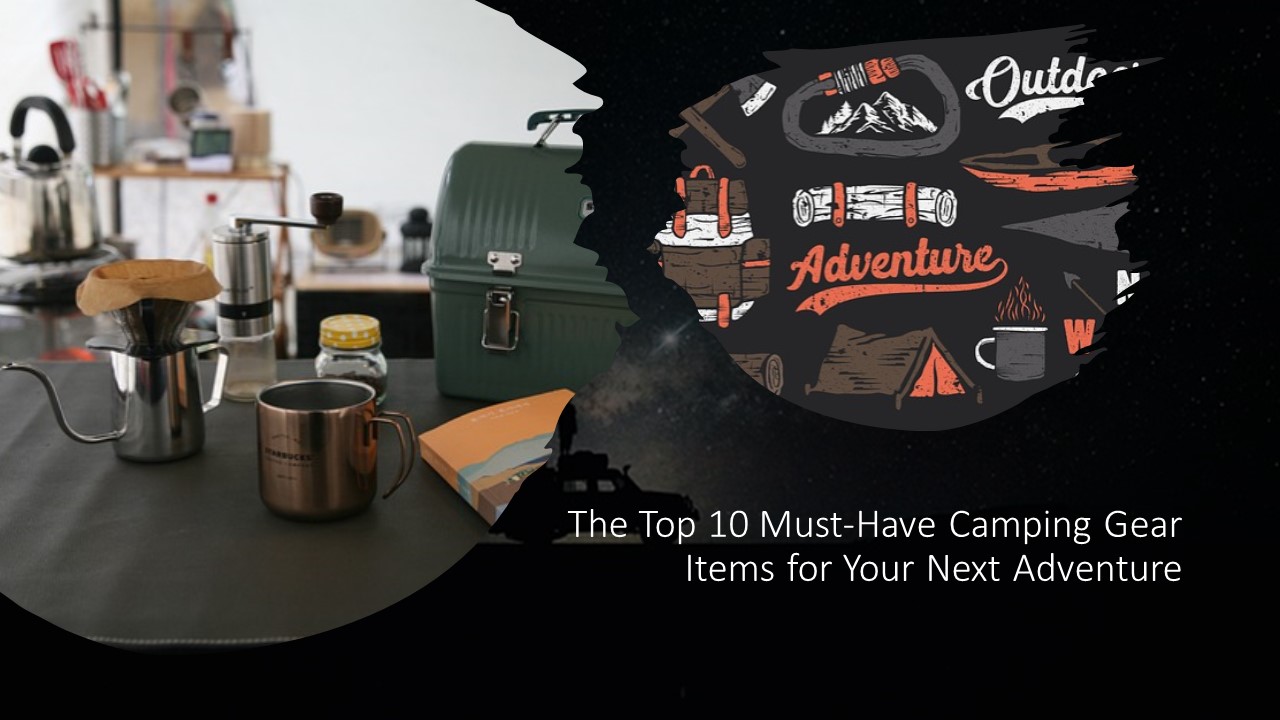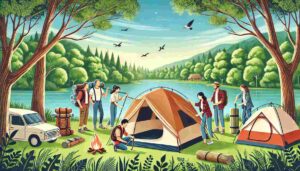Embarking on a camping adventure is an exciting way to reconnect with nature, escape the hustle and bustle of daily life, and create lasting memories with friends and family. But to ensure a comfortable and enjoyable experience, it’s crucial to be well-prepared with the right camping gear. In this blog post, we’ll delve into the top 10 must-have camping gear items that every camper should consider investing in. These essential items not only make your camping trips more enjoyable but can also enhance your safety and overall experience in the great outdoors. Read on to discover the best camping equipment that will elevate your next adventure to new heights.
1. Tent
A tent is arguably the most crucial piece of equipment for any camping trip. It serves as your home away from home, providing shelter, protection, and a cozy space to rest after a long day of exploring the outdoors. When selecting a tent, consider the following key features:
Importance of a reliable and weather-resistant tent
- Protection from the elements: A high-quality tent will shield you from rain, wind, and even snow, ensuring a comfortable and dry stay in various weather conditions.
- Durability: Investing in a well-constructed tent made from strong materials ensures it will withstand harsh conditions and last for many camping trips to come.
- Ventilation: Proper airflow is essential to reduce condensation and maintain a comfortable temperature inside the tent.
Key features to consider (size, weight, setup)
- Size: Choose a tent that offers enough space for the number of occupants and their gear. Keep in mind that a tent’s capacity is often an optimistic estimate, so a “two-person” tent may be more comfortable for one camper with gear.
- Weight: Consider the tent’s weight, especially if you plan to backpack or hike to your campsite. Ultralight tents are available but may compromise durability or comfort for the sake of reducing weight.
- Setup: Look for tents with easy and quick setup features, such as color-coded poles or clips, to save time and frustration at the campsite.
Top tent recommendations and comparisons
- MSR Hubba Hubba NX 2-Person Lightweight Backpacking Tent: A popular choice for backpackers seeking a lightweight yet durable and spacious option.
- Coleman Sundome 4-Person Tent: An affordable and easy-to-set-up option for family car camping trips.
- Big Agnes Copper Spur HV UL2: A high-quality ultralight option with excellent weather resistance and interior space.
If you need more resources, here are the top 5 camping tents for extreme weather.
2. Sleeping Bag
A good night’s sleep is essential for enjoying your camping trip and staying energized for the day’s activities. A high-quality sleeping bag will keep you warm, comfortable, and well-rested throughout the night. Here are the key factors to consider when choosing a sleeping bag:
The significance of a comfortable and warm sleeping bag
- Temperature regulation: A sleeping bag tailored to the expected climate will help you maintain a comfortable body temperature and avoid overheating or feeling too cold during the night.
- Comfort: A well-designed sleeping bag can make a significant difference in the quality of your sleep, ensuring you wake up refreshed and ready for the day’s adventures.
Temperature ratings and insulation types
- Temperature rating: Sleeping bags are rated based on the lowest temperature they can comfortably handle. Choose a bag rated for the coldest temperature you expect to encounter on your camping trip.
- Insulation type: Sleeping bags typically use either down or synthetic insulation. Down is lighter, more compressible, and provides better warmth-to-weight ratio, but is less effective when wet. Synthetic insulation is more affordable, maintains warmth when damp, and dries faster, but is bulkier and less compressible.
Best sleeping bags for various camping conditions
- Western Mountaineering Alpinlite 20°F Down Sleeping Bag: A high-quality, lightweight option for three-season camping, featuring 850-fill down insulation and a comfortable mummy shape.
- NEMO Forte 20°F Synthetic Sleeping Bag: A versatile and affordable option with synthetic insulation and a unique “spoon” shape for extra room around the elbows and knees.
- REI Co-op Magma 15°F Down Sleeping Bag: A balance of performance, weight, and affordability, making it an excellent choice for backpacking and camping trips in colder conditions.
3. Backpack
A reliable and comfortable backpack is essential for carrying your camping gear, whether you’re hiking deep into the wilderness or setting up camp close to your vehicle. A well-designed backpack can make a significant difference in your overall camping experience. Consider the following factors when selecting a backpack:
Importance of a spacious and durable backpack
- Organization: A well-organized backpack allows you to access and pack your gear efficiently, saving time and frustration.
- Comfort: A backpack with proper padding and support will minimize strain on your shoulders and back, ensuring a more enjoyable hiking experience.
- Durability: High-quality materials and construction will ensure your backpack withstands the wear and tear of outdoor adventures.
Backpack capacity and weight distribution
- Capacity: Backpacks are measured in liters, and the ideal capacity depends on the length of your trip and the gear you need to carry. Daypacks typically range from 15 to 35 liters, while multi-day backpacking packs range from 40 to 70+ liters.
- Weight distribution: Look for a backpack with an adjustable suspension system, padded hip belt, and load-lifter straps to help distribute the weight evenly, reducing the strain on your back and shoulders.
Top backpack brands and models for different camping needs
- Osprey Atmos AG 65: A popular choice for multi-day backpacking trips, known for its comfortable Anti-Gravity suspension system and ample storage capacity.
- Deuter Speed Lite 20: A lightweight daypack suitable for short hikes or as a supplementary pack for car camping trips, offering excellent ventilation and organization.
- Gregory Baltoro 75: A high-capacity backpack designed for extended backcountry trips, featuring a robust suspension system and multiple access points for easy gear retrieval.
4. Camping Stove
A reliable camping stove allows you to cook warm meals and boil water for coffee, tea, or dehydrated meals, making it an indispensable part of your camping gear. Here are the key factors to consider when selecting a camping stove:
The convenience of a portable cooking system
- Portability: A lightweight and compact camping stove is easier to carry and set up at your campsite.
- Ease of use: Simple, user-friendly designs ensure hassle-free cooking and cleaning, enhancing your overall camping experience.
Fuel types and efficiency
- Canister stoves: These stoves use pre-pressurized isobutane-propane canisters, offering convenience, a lightweight design, and fast boil times. However, they may struggle in cold temperatures or high altitudes.
- Liquid fuel stoves: These stoves run on white gas, kerosene, or other liquid fuels, providing better performance in cold weather and high altitudes, but are typically heavier and require more maintenance.
- Alternative fuel stoves: These stoves utilize solid fuel tablets, wood, or alcohol, offering a lightweight and eco-friendly option, but may be less efficient and slower to cook.
Best camping stoves for different group sizes and preferences
- MSR PocketRocket 2: A lightweight and compact canister stove, ideal for solo travelers or small groups, offering quick boil times and easy setup.
- Coleman Classic Propane Stove: A two-burner, freestanding stove suitable for car camping or larger groups, providing ample cooking space and adjustable heat controls.
- BioLite CampStove 2: A wood-burning stove that also charges electronic devices, offering a sustainable and versatile cooking option for eco-conscious campers.
5. Water Filter/Purifier
Access to clean and safe drinking water is crucial during any camping trip. A portable water filter or purifier can remove harmful bacteria, protozoa, and other contaminants, ensuring you stay hydrated and healthy. Here are the key factors to consider when selecting a water filter or purifier:
Ensuring access to clean and safe drinking water
- Health and safety: A reliable water filter or purifier can help prevent waterborne illnesses, making your camping experience safer and more enjoyable.
- Convenience: Having a portable water treatment system allows you to access clean water from nearby sources without needing to carry large quantities.
Different water filtration and purification methods
- Pump filters: These devices use a manual pump to push water through a filter, effectively removing bacteria and protozoa. They are reliable and suitable for groups but can be time-consuming and require regular maintenance.
- Gravity filters: These systems use gravity to force water through a filter, making them convenient for larger groups or base camps. They are typically slower than pump filters but require less effort.
- UV purifiers: These devices use ultraviolet light to kill bacteria, viruses, and protozoa. They are lightweight and fast but require batteries and may not be effective in murky water.
- Chemical treatments: Tablets or drops can be used to disinfect water, killing bacteria, viruses, and protozoa. These treatments are lightweight and inexpensive but may leave an unpleasant taste and take longer to work.
Top water filters and purifiers for campers
- Sawyer Squeeze Water Filtration System: A lightweight and versatile option that attaches directly to water bottles or hydration bladders, effectively removing bacteria and protozoa.
- Platypus GravityWorks 4.0L Water Filter System: A high-capacity gravity filter suitable for groups or base camps, offering fast flow rates and easy setup.
- SteriPEN Ultra UV Water Purifier: A compact and lightweight UV purifier that quickly kills bacteria, viruses, and protozoa, making it ideal for solo travelers or small groups.
6. Multi-tool
A versatile multi-tool is an invaluable piece of camping equipment that can help you perform various tasks, from preparing meals to making quick repairs. Here are the essential factors to consider when selecting a multi-tool for camping:
The versatility of a multi-tool for camping tasks
- Efficiency: A multi-tool combines multiple functions into one compact device, saving you space and weight in your backpack.
- Adaptability: With a variety of tools at your disposal, a multi-tool enables you to tackle various challenges and tasks that may arise during your camping trip.
Essential components and features
- Knife: A sharp and sturdy blade is essential for food preparation, cutting cordage, and other camping tasks.
- Pliers: Useful for gripping and manipulating small objects, tightening bolts, or bending wire.
- Screwdrivers: Both flathead and Phillips screwdrivers can help with gear repairs and adjustments.
- Can/bottle opener: A must-have for opening canned food or enjoying a refreshing beverage at the campsite.
- Scissors: Handy for trimming fabric, cutting bandages, or other precise cutting tasks.
- Saw: Useful for cutting small branches or notching wood for tent stakes.
- Additional tools: Depending on your camping needs, you may also want a multi-tool with a firestarter, awl, or other specialized tools.
Best multi-tools for camping enthusiasts
- Leatherman Wave+: A popular choice among campers, featuring 18 tools, including pliers, knives, and screwdrivers, in a compact and durable design.
- Victorinox Swiss Army Huntsman: A classic option with 15 functions, including a wood saw, scissors, and a corkscrew, making it suitable for various camping tasks.
- Gerber Suspension Multi-Plier: An affordable and lightweight option with 12 functions, including a locking system for added safety during use.
7. Headlamp
A reliable headlamp is an essential piece of gear for any camper, providing hands-free illumination for various tasks, from setting up camp to navigating trails after dark. Here are the key factors to consider when selecting a headlamp for camping:
The necessity of hands-free lighting
- Convenience: A headlamp allows you to use both hands for tasks such as cooking, setting up your tent, or reading a map.
- Safety: Adequate lighting helps prevent accidents and injuries by allowing you to see obstacles and hazards in your path.
Important features and specifications
- Brightness: Measured in lumens, the brightness of a headlamp should be suitable for your intended use. Higher lumens provide more powerful illumination, while lower lumens offer longer battery life.
- Beam distance: The range of the headlamp’s light is essential for tasks such as route-finding or spotting distant objects.
- Battery life: Consider how long the headlamp can run on a single set of batteries or charge, and whether it uses rechargeable or disposable batteries.
- Comfort and fit: A comfortable headlamp with an adjustable strap will ensure a secure fit during extended use.
- Water resistance: A water-resistant headlamp will continue to function in wet conditions, protecting your investment and ensuring you have reliable lighting in any weather.
Top headlamps for various camping needs
- Black Diamond Spot: A versatile headlamp with multiple brightness settings, a waterproof rating, and a long battery life, suitable for various camping activities.
- Petzl Actik Core: A rechargeable headlamp offering powerful illumination and multiple lighting modes, ideal for those who prefer a sustainable and eco-friendly option.
- BioLite HeadLamp 330: A lightweight and comfortable headlamp with an integrated rechargeable battery, providing excellent balance and weight distribution during extended use.
8. First Aid Kit
A well-stocked first aid kit is an essential piece of camping gear, ensuring you’re prepared to handle minor injuries and emergencies during your trip. Here are the key factors to consider when assembling or selecting a first-aid kit for camping:
The importance of being prepared for medical emergencies
- Safety: A first aid kit can help you treat minor injuries, preventing them from becoming more severe or debilitating.
- Peace of mind: Knowing you’re prepared for medical emergencies can make your camping experience more enjoyable and less stressful.
Essential items for a camping first aid kit
- Bandages and gauze: Assorted adhesive bandages, gauze pads, and rolled gauze for covering and protecting wounds.
- Antiseptic wipes and ointments: For cleaning and disinfecting cuts, scrapes, and abrasions.
- Tweezers and a small pair of scissors: Useful for removing splinters, cutting gauze, or trimming medical tape.
- Pain relievers: Over-the-counter pain relievers, such as ibuprofen or aspirin, to help manage pain and inflammation.
- Elastic bandage: For providing support and compression to sprains or strains.
- Moleskin or blister pads: To protect and alleviate pain from blisters or hot spots.
- Medical tape: To secure bandages, gauze, or splints.
- Disposable gloves: To protect against infection when treating others.
- First aid manual or guide: A compact reference for treating common outdoor injuries and emergencies.
- Personal medications and items: Include any prescription medications, insect repellent, sunscreen, or other personal necessities.
Top pre-assembled first aid kits for campers
- Adventure Medical Kits Ultralight/Watertight .7: A lightweight and compact first aid kit with essential items for solo travelers or small groups.
- REI Co-op Backpacker Extended First Aid Kit: A comprehensive kit designed for multi-day trips or larger groups, including a variety of medical supplies and a first aid guide.
- Surviveware Small First Aid Kit: A durable, water-resistant kit with organized compartments for easy access to supplies, making it suitable for various outdoor activities.
9. Navigation Tools
Effective navigation tools are crucial for staying on track and finding your way during your camping trip. A combination of traditional and modern navigation tools can help ensure you don’t get lost and can find your way back to camp. Here are the key factors to consider when selecting navigation tools for camping:
The importance of reliable navigation tools
- Safety: Knowing your location and being able to navigate unfamiliar terrain can help prevent you from getting lost and facing potentially dangerous situations.
- Confidence: Having reliable navigation tools can give you the confidence to explore new areas and enjoy your camping experience to the fullest.
Essential navigation tools for camping
- Map: A detailed topographic map of the area you’re camping in can provide valuable information about the terrain, trails, and landmarks.
- Compass: A reliable compass can help you determine your direction and navigate using a map. Choose a compass with a sighting mirror, adjustable declination, and a rotating bezel for greater accuracy.
- GPS device: A handheld GPS or GPS-enabled smartphone can provide real-time location data, route tracking, and waypoints. Ensure you have spare batteries or a power bank to keep your device charged.
- Altimeter: An altimeter can measure your elevation, which can be useful for determining your location on a map and assessing your progress on a hike.
- Backup navigation tools: Always carry backup navigation tools, such as a paper map and a compass, in case your electronic devices fail or run out of power.
Top navigation tools for campers
- Garmin GPSMAP 66s: A rugged and reliable handheld GPS device with a high-resolution display, preloaded maps, and advanced navigation features.
- Suunto MC-2G Global Compass: A high-quality compass with adjustable declination, sighting mirror, and global needle for accurate navigation in any location.
- Gaia GPS App: A comprehensive GPS app for smartphones, offering downloadable maps, route planning, and tracking features. Pair it with a waterproof phone case and a portable charger for extended use in outdoors.
10. Portable Power Source
A portable power source can keep your electronic devices charged during your camping trip, ensuring you have access to communication, navigation, and entertainment when you need it. Here are the key factors to consider when selecting a portable power source for camping:
The benefits of a portable power source
- Convenience: Keep your electronic devices charged and ready to use, even when you’re away from traditional power sources.
- Safety: Ensure your communication and navigation devices have enough power to last throughout your trip, helping you stay connected and on track.
Different types of portable power sources
- Power banks: Compact and lightweight, power banks store electricity that can be used to charge your devices via USB. Choose a power bank with enough capacity (measured in milliamp-hours, or mAh) to meet your charging needs.
- Solar chargers: Solar panels can convert sunlight into electricity to charge your devices, making them an eco-friendly option. They can be slower to charge devices, especially in cloudy conditions, but are a sustainable and renewable power source.
- Battery packs: Larger and more powerful than power banks, battery packs can charge multiple devices simultaneously and often include additional features, such as a built-in flashlight or an air pump for inflatables.
Top portable power sources for campers
- Anker PowerCore 20100mAh: A high-capacity power bank with a compact design, offering multiple charges for smartphones and other USB devices.
- Goal Zero Nomad 10 Solar Panel: A lightweight and portable solar charger that can be attached to your backpack to charge devices while you hike or explore.
- Jackery Explorer 240 Portable Power Station: A versatile battery pack with multiple output ports, capable of charging smartphones, tablets, laptops, and small appliances, making it suitable for car camping or extended trips.
Conclusion
A well-planned camping trip requires the right gear to ensure a comfortable, safe, and enjoyable experience. By investing in these top 10 must-have camping gear items, you’ll be prepared for any adventure that comes your way:
- Tent
- Sleeping Bag
- Backpack
- Camping Stove
- Water Filter/Purifier
- Multi-tool
- Headlamp
- First Aid Kit
- Navigation Tools
- Portable Power Source
Whether you’re a seasoned camper or new to the great outdoors, these essential items will enhance your outdoor experiences, allowing you to focus on creating unforgettable memories in nature. Happy camping!










